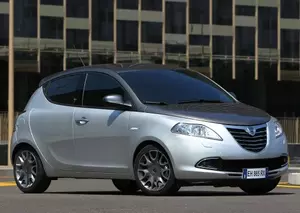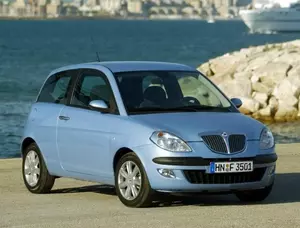
| Vehicle | Precise engine size | Difference from world average | Engine size to consumption ratio | Horsepower from 1 L | Engine size to 100 kg of weight |
|---|---|---|---|---|---|
| 1.2 |
1.24 L (1242 cc) |
47.1% smaller | 28 cc to 1 mpg | 56 hp from 1 L | 124 cc to 100 kg |
| 0.9 TwinAir |
0.88 L (875 cc) |
62.7% smaller | 16 cc to 1 mpg | 97 hp from 1 L | 88 cc to 100 kg |
| 0.9 |
0.88 L (875 cc) |
62.7% smaller | 17 cc to 1 mpg | 91 hp from 1 L | 80 cc to 100 kg |
| 1.3 MultiJet2 |
1.25 L (1248 cc) |
46.8% smaller | 20 cc to 1 mpg | 76 hp from 1 L | 113 cc to 100 kg |
| Vehicle | 1.2 |
|---|---|
| Precise engine size | 1.24 L (1242 cc) |
| Difference from world average | 47.1 smaller |
| Engine size to consumption ratio | 28 cc to 1 mpg |
| Horsepower from 1 L | 56 hp from 1 L |
| Engine size to 100 kg of weight | 124 cc to 100 kg |
| Vehicle | 0.9 TwinAir |
| Precise engine size | 0.88 L (875 cc) |
| Difference from world average | 62.7 smaller |
| Engine size to consumption ratio | 16 cc to 1 mpg |
| Horsepower from 1 L | 97 hp from 1 L |
| Engine size to 100 kg of weight | 88 cc to 100 kg |
| Vehicle | 0.9 |
| Precise engine size | 0.88 L (875 cc) |
| Difference from world average | 62.7 smaller |
| Engine size to consumption ratio | 17 cc to 1 mpg |
| Horsepower from 1 L | 91 hp from 1 L |
| Engine size to 100 kg of weight | 80 cc to 100 kg |
| Vehicle | 1.3 MultiJet2 |
| Precise engine size | 1.25 L (1248 cc) |
| Difference from world average | 46.8 smaller |
| Engine size to consumption ratio | 20 cc to 1 mpg |
| Horsepower from 1 L | 76 hp from 1 L |
| Engine size to 100 kg of weight | 113 cc to 100 kg |

| Vehicle | Precise engine size | Difference from world average | Engine size to consumption ratio | Horsepower from 1 L | Engine size to 100 kg of weight |
|---|---|---|---|---|---|
| 1.2 |
1.24 L (1242 cc) |
47.1% smaller | 28 cc to 1 mpg | 56 hp from 1 L | 124 cc to 100 kg |
| 0.9 TwinAir |
0.88 L (875 cc) |
62.7% smaller | 16 cc to 1 mpg | 97 hp from 1 L | 88 cc to 100 kg |
| 1.3 MultiJet2 |
1.25 L (1248 cc) |
46.8% smaller | 20 cc to 1 mpg | 76 hp from 1 L | 113 cc to 100 kg |
| 0.9 |
0.88 L (875 cc) |
62.7% smaller | 17 cc to 1 mpg | 91 hp from 1 L | 80 cc to 100 kg |
| Vehicle | 1.2 |
|---|---|
| Precise engine size | 1.24 L (1242 cc) |
| Difference from world average | 47.1 smaller |
| Engine size to consumption ratio | 28 cc to 1 mpg |
| Horsepower from 1 L | 56 hp from 1 L |
| Engine size to 100 kg of weight | 124 cc to 100 kg |
| Vehicle | 0.9 TwinAir |
| Precise engine size | 0.88 L (875 cc) |
| Difference from world average | 62.7 smaller |
| Engine size to consumption ratio | 16 cc to 1 mpg |
| Horsepower from 1 L | 97 hp from 1 L |
| Engine size to 100 kg of weight | 88 cc to 100 kg |
| Vehicle | 1.3 MultiJet2 |
| Precise engine size | 1.25 L (1248 cc) |
| Difference from world average | 46.8 smaller |
| Engine size to consumption ratio | 20 cc to 1 mpg |
| Horsepower from 1 L | 76 hp from 1 L |
| Engine size to 100 kg of weight | 113 cc to 100 kg |
| Vehicle | 0.9 |
| Precise engine size | 0.88 L (875 cc) |
| Difference from world average | 62.7 smaller |
| Engine size to consumption ratio | 17 cc to 1 mpg |
| Horsepower from 1 L | 91 hp from 1 L |
| Engine size to 100 kg of weight | 80 cc to 100 kg |

| Vehicle | Precise engine size | Difference from world average | Engine size to consumption ratio | Horsepower from 1 L | Engine size to 100 kg of weight |
|---|---|---|---|---|---|
| 1.2 i |
1.24 L (1242 cc) |
47.1% smaller | 32 cc to 1 mpg | 48 hp from 1 L | 138 cc to 100 kg |
| 1.2 i 16V |
1.24 L (1242 cc) |
47.1% smaller | 32 cc to 1 mpg | 65 hp from 1 L | 124 cc to 100 kg |
| 1.3 16V CDRi Multijet |
1.25 L (1251 cc) |
46.7% smaller | 25 cc to 1 mpg | 56 hp from 1 L | 125 cc to 100 kg |
| 1.4 i 16V |
1.37 L (1368 cc) |
41.7% smaller | 38 cc to 1 mpg | 69 hp from 1 L | 137 cc to 100 kg |
| Vehicle | 1.2 i |
|---|---|
| Precise engine size | 1.24 L (1242 cc) |
| Difference from world average | 47.1 smaller |
| Engine size to consumption ratio | 32 cc to 1 mpg |
| Horsepower from 1 L | 48 hp from 1 L |
| Engine size to 100 kg of weight | 138 cc to 100 kg |
| Vehicle | 1.2 i 16V |
| Precise engine size | 1.24 L (1242 cc) |
| Difference from world average | 47.1 smaller |
| Engine size to consumption ratio | 32 cc to 1 mpg |
| Horsepower from 1 L | 65 hp from 1 L |
| Engine size to 100 kg of weight | 124 cc to 100 kg |
| Vehicle | 1.3 16V CDRi Multijet |
| Precise engine size | 1.25 L (1251 cc) |
| Difference from world average | 46.7 smaller |
| Engine size to consumption ratio | 25 cc to 1 mpg |
| Horsepower from 1 L | 56 hp from 1 L |
| Engine size to 100 kg of weight | 125 cc to 100 kg |
| Vehicle | 1.4 i 16V |
| Precise engine size | 1.37 L (1368 cc) |
| Difference from world average | 41.7 smaller |
| Engine size to consumption ratio | 38 cc to 1 mpg |
| Horsepower from 1 L | 69 hp from 1 L |
| Engine size to 100 kg of weight | 137 cc to 100 kg |

| Vehicle | Precise engine size | Difference from world average | Engine size to consumption ratio | Horsepower from 1 L | Engine size to 100 kg of weight |
|---|---|---|---|---|---|
| 1.2 |
1.24 L (1242 cc) |
47.1% smaller | 34 cc to 1 mpg | 48 hp from 1 L | 138 cc to 100 kg |
| 1.2 16V |
1.24 L (1242 cc) |
47.1% smaller | - | 69 hp from 1 L | 138 cc to 100 kg |
| 1.1 |
1.11 L (1108 cc) |
52.8% smaller | - | 49 hp from 1 L | 123 cc to 100 kg |
| 1.2 i 16V |
1.24 L (1242 cc) |
47.1% smaller | - | 65 hp from 1 L | 138 cc to 100 kg |
| 1.4 12V |
1.37 L (1370 cc) |
41.6% smaller | 40 cc to 1 mpg | 58 hp from 1 L | 152 cc to 100 kg |
| Vehicle | 1.2 |
|---|---|
| Precise engine size | 1.24 L (1242 cc) |
| Difference from world average | 47.1 smaller |
| Engine size to consumption ratio | 34 cc to 1 mpg |
| Horsepower from 1 L | 48 hp from 1 L |
| Engine size to 100 kg of weight | 138 cc to 100 kg |
| Vehicle | 1.2 16V |
| Precise engine size | 1.24 L (1242 cc) |
| Difference from world average | 47.1 smaller |
| Engine size to consumption ratio | - |
| Horsepower from 1 L | 69 hp from 1 L |
| Engine size to 100 kg of weight | 138 cc to 100 kg |
| Vehicle | 1.1 |
| Precise engine size | 1.11 L (1108 cc) |
| Difference from world average | 52.8 smaller |
| Engine size to consumption ratio | - |
| Horsepower from 1 L | 49 hp from 1 L |
| Engine size to 100 kg of weight | 123 cc to 100 kg |
| Vehicle | 1.2 i 16V |
| Precise engine size | 1.24 L (1242 cc) |
| Difference from world average | 47.1 smaller |
| Engine size to consumption ratio | - |
| Horsepower from 1 L | 65 hp from 1 L |
| Engine size to 100 kg of weight | 138 cc to 100 kg |
| Vehicle | 1.4 12V |
| Precise engine size | 1.37 L (1370 cc) |
| Difference from world average | 41.6 smaller |
| Engine size to consumption ratio | 40 cc to 1 mpg |
| Horsepower from 1 L | 58 hp from 1 L |
| Engine size to 100 kg of weight | 152 cc to 100 kg |

| Vehicle | Precise engine size | Difference from world average | Engine size to consumption ratio | Horsepower from 1 L | Engine size to 100 kg of weight |
|---|---|---|---|---|---|
| 1.1i |
1.11 L (1108 cc) |
52.8% smaller | 29 cc to 1 mpg | 46 hp from 1 L | 139 cc to 100 kg |
| 1.1 Fire |
1.11 L (1108 cc) |
52.8% smaller | 28 cc to 1 mpg | 45 hp from 1 L | 139 cc to 100 kg |
| 1.1 i 4X4 |
1.11 L (1108 cc) |
52.8% smaller | 33 cc to 1 mpg | 46 hp from 1 L | 123 cc to 100 kg |
| 1.3 i |
1.3 L (1301 cc) |
44.5% smaller | 39 cc to 1 mpg | 57 hp from 1 L | 145 cc to 100 kg |
| Vehicle | 1.1i |
|---|---|
| Precise engine size | 1.11 L (1108 cc) |
| Difference from world average | 52.8 smaller |
| Engine size to consumption ratio | 29 cc to 1 mpg |
| Horsepower from 1 L | 46 hp from 1 L |
| Engine size to 100 kg of weight | 139 cc to 100 kg |
| Vehicle | 1.1 Fire |
| Precise engine size | 1.11 L (1108 cc) |
| Difference from world average | 52.8 smaller |
| Engine size to consumption ratio | 28 cc to 1 mpg |
| Horsepower from 1 L | 45 hp from 1 L |
| Engine size to 100 kg of weight | 139 cc to 100 kg |
| Vehicle | 1.1 i 4X4 |
| Precise engine size | 1.11 L (1108 cc) |
| Difference from world average | 52.8 smaller |
| Engine size to consumption ratio | 33 cc to 1 mpg |
| Horsepower from 1 L | 46 hp from 1 L |
| Engine size to 100 kg of weight | 123 cc to 100 kg |
| Vehicle | 1.3 i |
| Precise engine size | 1.3 L (1301 cc) |
| Difference from world average | 44.5 smaller |
| Engine size to consumption ratio | 39 cc to 1 mpg |
| Horsepower from 1 L | 57 hp from 1 L |
| Engine size to 100 kg of weight | 145 cc to 100 kg |